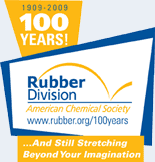Centennial Elite Sponsors
|
35
Nanofillers for elastomers
Tuesday, October 13, 2009: 3:45 PM
330 (David L. Lawrence Convention Center )
Attilio Citterio
,
Politecnico di Milano, Milano, Italy
Nanofillers for elastomers
Maurizio Galimbertia Attilio Citteriob
aPirelli Tyre, Viale Sarca 222, 20126 Milano (I) bPolitecnico di Milano, Via Mancinelli 7, 20131 Milano (I)
Te properties of an elastomer are not enough for applications useful for human life, not even after vulcanization, and the required physical mechanical properties are achieved only through reinforcement with fillers. Reinforcing fillers are in the nanometer size range, at least in one dimension, and nanocomposites are thus formed by blending their rigid insoluble particles “having one or more dimensions of the order of 100 nm or less” [1] with an elastomer. A large number of nanofillers have been introduced into a rubber, over more than hundred years, starting from carbon black and silica.
The Nano Era has made available new families of nanofillers, actively investigated both in the academic and industrial fields and to a different extent already applied for elastomer nanocomposites [2]. Layered clays, carbon nanotubes and silica nanoparticles are in particular considered in this presentation.
Layered clays have been acquiring an increasing interest, on the basis of a safe toxicologic profile, a large availability as inexpensive natural mineral fillers and a remarkable improvement of physical mechanical as well as barrier properties [3]. Carbon nanotubes have already shown outstanding combination of reinforcement and electrical conductivity whereas elastomeric composites with silica nanoparticles were reported to have improved abrasion resistance.
In our previous works, clay layering in hydrocarbon elastomers was investigated, reporting the preparation of tailor made nanostructures [4] and the ammonium salts, used as clay modifiers, were shown to easily form compounds such as amines, highly reactive with the other components of a crosslinkable elastomeric composition [5].
This work presents a vis a vis comparison of the abovementioned nanofillers in an elastomeric composition, focusing the attention on physical and geometrical features of nanofillers, such as surface area, size and shape, on nanostructuring as well as on the chemistry involved for promoting the interaction of nanofillers with the elastomeric matrix.
The rheological behaviour of raw compositions in a constant flow regime and the physical mechanical properties of sulphur cured compounds are presented. The reinforcement promoted by said nanofillers at low and high strain amplitude is in particular discussed., investigating the filler percolation threshold and thus trying to elucidate the role played by individual filler components and by their interaction. The origin of reinforcement proposed by said nanofillers is discussed and comments on the mechanism of filler networking are proposed.
[1] http://www.bsi-global.com/en/Standards-and-Publications/Industry-Sectors/ Nanotechnologies/ PAS-71/Download-PAS-712005-Vocabulary-Nanoparticles
[2] Maiti M., Bhattacharya M., Bhowmick A.K. Rubber Chemistry and Technology 2008, 81, 384.
[3] Sengupta R.; Chakraborty S.; Bandyopadhyay S.; Dasgupta S.; Mukhopadhyay R.; Auddy K.; Deuri A.S. Polym. Eng. Sci. 2007, 1956.
[4] (a) Galimberti M., Lostritto A., Spatola A., Guerra G., Chem. Mater. 2007, 19, 2495–2499 (b) Galimberti M., Senatore S., Conzatti L., Costa G., Giuliano G., Guerra G., Polym. Adv. Technol. 2009, 20 135 (c)
[5] Galimberti M., Martino M., Guenzi M., Leonardi G., Citterio A., to be published on e-polymers
|
![[ Visit ACS Rubber Website ]](images/logo.jpg)









